
During a short walk in the bush with ecologist and forest activist Mark Graham, time itself has a way of slipping and folding. One moment his attention is in the spongy soil and wet foliage at our feet. “Shhh,” he says. “Sphagnum frog.”
We fall to silence and listen. “It sounds like a little wet fart,” he says, eyes shining in wonder. I hear nothing, but Graham purses his lips to mimic the frog admirably.
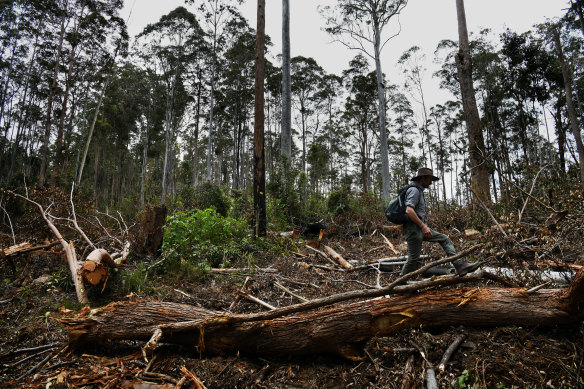
New research has found logging zones create dry wind tunnels; highways for conflagrations that burn hotter and faster than in undisturbed wilderness.Credit:Dean Sewell
Next, his attention flicks to the leaf-litter itself, and he tells us how scientists studying fossilised remains of such detritus linked it to ancient forests in Patagonia.
I later find a research paper on the fossil records showing that during the Eocene period, between 56 and 44 million years ago, forests of the same ferns and towering tallowwoods we are now standing among stretched across swathes of the great southern landmass of Gondwanaland.
Pockets still remain on Australia’s east coast, like this one in the Ellis State Forest on the high Dorrigo Plateau, 60 kilometres inland and about 50 million years from the growing city of Coffs Harbour on the NSW north coast.
We walk a few hundred metres along a shaded track and pass a giant stump still marked by the pockets cut into its waist a century or so ago by wood choppers so they could sink home the jigger boards they would stand on as they felled the giant.
We pause again as Graham identifies the staccato call of an Australian logrunner, walk on, and then burst into blazing sunlight.
This coupe has been logged just days before. But for a handful of giant trees marked with fluorescent pink spray paint to identify them as potential habitat trees to be protected, everything is gone.
The ground is undulating drying soil compacted by the treads of mechanised logging harvesters and skidders. It resembles a construction site before a concrete slab is poured, but for the occasional mounds of leaf litter and forest trash.
According to new research by ANU Professor David Lindenmayer, one of the world’s most esteemed forest researchers, far from stemming bushfires by reducing fuel as the industry commonly asserts, these logging zones create dry wind tunnels through rainforests; highways for conflagrations that burn hotter and faster than in undisturbed wilderness.
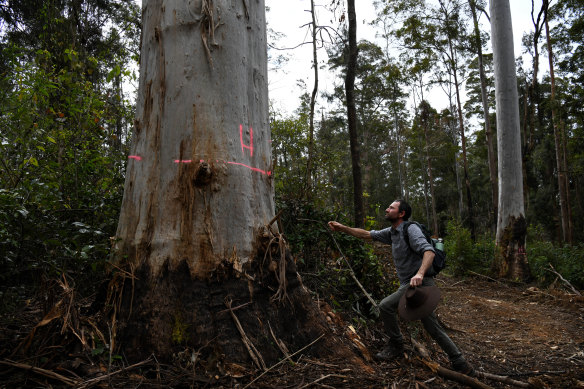
A habitat tree, marked for preservation, but not protection from damage from logging machinery.Credit:Dean Sewell
There was a time when regulations dictated that trees marked for preservation be protected by five-metre buffer zones, not just to protect the big trees but to maintain an understory around them. That regulation was scrapped in 2018 and Graham shows us the scars where machinery has ripped through the bark at the base of the preserved trees.
These wounds can open trees to infection and shorten life spans that might otherwise stretch longer than 500 years.
Nearby a blue gum marked in pink fluoro still stands, its bark scratched from base to canopy with the distinctive diagonal tracks left by koala claws.
A stone’s throw away another tree has been marked for preservation, but it is long dead. Nearby is the fresh weeping stump of a brush box Graham says he has measured at 151 centimetres in diameter. By regulation, trees measuring greater than 140 centimetres are protected.
Graham seethes as he conducts us around the site. For years the former National Parks ranger and environmental consultant has lived among these forests and studied them, and campaigned to protect them.
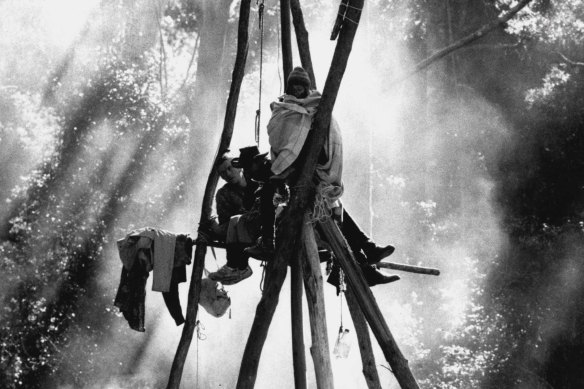
Anti-logging protesters atop a timber tripod used to block a road in the Chaelundi State Forest west of Dorrigo during the forest wars in 1991.Credit:Kenneth Stevens
Since fires wiped out an estimated 64 per cent of the state’s forests, Graham’s activism has ticked up, along with that of anti-logging protests up and down the coast.
Today the logging wars of the 1980s and 1990s that ended in truce at the turn of the century with the adoption of what were called Regional Forestry Agreements are reigniting.
(Graham is bound up in this tension. He shares footage that appears to show him being assaulted on a public road by logging contractors, and shortly after we meet he was arrested at a protest. He faces a range of charges, which he is contesting.)
The Regional Forestry Agreements were designed to provide certainty of access to wood supply for the timber industry, ecologically sustainable forest management and a permanent forest conservation estate.
A report by the NSW Natural Resource Commission in 2020 but never officially released by the government recommended that logging be suspended in three areas – two on the south coast and one on the north – due to the devastation of the fires.
With timber less plentiful for harvest after the fires, loggers, directed by technologies such as air-deployed LiDAR systems, are pushing ever deeper into forests to find the remaining stands of tall and valuable timber.
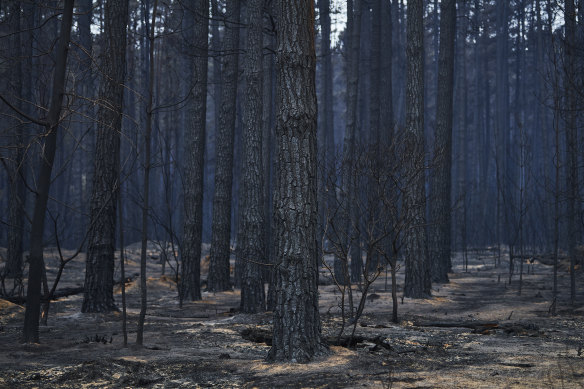
The Black Summer fires have made it harder to source timber from state forests.Credit:Getty Images
The tragedy for species such as koalas is that these are the habitats they depend upon most.
On a rare sunny day last weekend hundreds of people gathered in a public hall in Coffs Harbour to attend a day-long conference organised by peak environment bodies, the former Liberal NSW Upper House MP Catherine Cusack and Justin Field, an independent who will retire at the next election, to discuss the future of the koala in NSW. The conference was called The Vanishing.
One speaker was the koala ecologist Dr Steve Philips who laid out the evidence that once regional koala populations begin to decline, their extinction becomes nearly inevitable.
“In the case of the Pittwater/ Barrenjoey population it was a tyranny of small decisions,” he says. “It was habitat loss, habitat fragmentation, it was urban expansion, it was vehicle strike, it was domestic dog attack. They were on a decline trajectory, they disappeared from the landscape – they are now extinct. They’re gone.”
He agrees with the findings of the recent NSW Upper House inquiry chaired by Greens MP Cate Faehrmann, which predicts that by 2050, far from having their numbers doubled by 2050 as the NSW government has promised, koalas will no longer exist in the state.
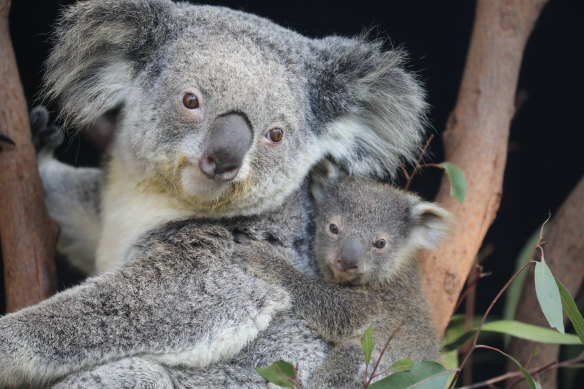
Once koalas begin the slide to extinction, it is difficult to reverse.
Raising the broader implication of the loss of the koala, Faehrmann observed, “If we can’t save the most loved animal not only in this country but many would argue the world, I honestly don’t believe we can save ourselves.”
At the conference two big ideas were considered crucial to the protection of the animal. The first was the creation of the Great Koala National Park, a proposal to combine 175,000 ha of state forests with another 140,000 ha of existing protected public land in the Coffs Harbour region.
The park would include areas like the ancient Ellis State Forest described above, and protect two crucial koala populations containing around 20 per cent of the state’s remaining koalas.
The proposal is backed by tourism operators in the region, the Greens and Labor as well as Sally Townley, the Coffs Harbour deputy mayor, who is running as an independent in the next state election. It is not supported by the government.
The second idea is to follow the lead of both Western Australia and Victoria and simply phase out native forest logging on publicly owned land entirely in favour of an expanded plantation industry.
This, obviously, was the solution favoured in Coffs Harbour last weekend. It is also supported by the Greens and environmental groups, though not by Labor or the Coalition government.
Indeed, supporters of the plan say such a move would actually save money because, they claim, the industry is at present running at a loss.
“If we can save taxpayers money and save ancient forests, and save species that are going extinct, why would we not do it,” says Stuart Blanch, a conservation scientist with WWF, which recently commissioned a report by Frontier Economics on the costs and benefits of winding down the industry.
The report estimates the phase-out would cost the government about $302 million over 10 years for a support package that would include worker redundancies and retraining, buy-backs of wood supply contracts, and support for diversifying regional economies.
Loading
But it would save the government hundreds of millions in payments it makes to sustain the state-owned forestry company, Forestry Corp NSW, the report says. It lists as examples an estimated $180 million in “regular structural adjustment and event-related payments” since 2010, as well as so-called Community Service Obligation payments that the industry must pay to use state-owned resources, estimated at around $160 million over the past decade.
It also notes a recent one-off payment from the government to Forestry Corp of $105 million in the form of “stimulus, equity and dividend relief”.
But chief executive of Australian Forest Products Association NSW Victor Violante said the report misrepresented the state of the industry and the cost to the broader state economy should it be closed.
“The untold story is that closing NSW’s hardwood timber industry would cost the NSW economy more than $1 billion a year in economic activity, and mean higher housing construction costs, lengthy delays on new home builds and renovations, shortages of firewood to heat our homes, and fewer firefighting resources in bushfire prone areas.
“If we can’t save the most loved animal not only in this country but, many would argue, the world, I don’t believe we can save ourselves.”
Cate Faehrmann
“Ending native timber harvesting would mean the closure of NSW’s vital hardwood] timber mills that produce essential hardwood timber products and support thousands of jobs across the state. It is not a tap that can just be turned off, and the report offers no answers to where else these products would come from,” Violante said.
In September, a petition of 20,000 people was delivered to parliament. It called for a moratorium on logging in native forests until the government responds to the leaked NRC report, and for a plan to phase out the industry.
Responding to the petition, Agriculture Minister Dugald Saunders, a member of the Nationals, wrote that many thousands of jobs relied upon the work and that harvesting took place in just 1 per cent of state forests each year, which is just 0.1 per cent of the broader forested landscape.
“When forests are managed sustainably,” he wrote, “they deliver a vast range of benefits for our communities, including regional tourism drawcards, clean waterways and habitat for protected wildlife.”
Catherine Cusack, who once served as shadow environment minister, says she believes the Nationals are intent on protecting logging and some agriculture industries.
Loading
Liberals in turn, she says, have proved willing to secure Nationals’ support for their climate and energy policies by ceding ground on natural resources. This was deal made to end the so-called koala wars between the Coalition partners, she says.
“The science is clear, the state’s koalas are on track for extinction by 2050, and destroying their habitat is the main reason,” says Cusack. At the conference she added in typically blunt terms her view that politicians who failed to respond faced extinction faster than koalas.
Get to the heart of what’s happening with climate change and the environment. Our fortnightly Environment newsletter brings you the news, the issues and the solutions. Sign up here.









 Add Category
Add Category